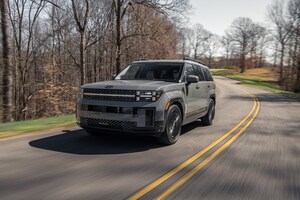All-new 2011 Sonata Adds a Second, Even More Powerful Engine Delivering Best-in-Class Horsepower and Fuel Economy
Twin-Scroll Turbocharger and Direct Injection Give Sonata 2.0T an Estimated 274 HP, 34 MPG, on Regular Fuel
- The Sonata 2.0T debuts with Hyundai's first four-cylinder turbocharged gasoline direct-injection engine
- With a best-in-class 34 mpg highway fuel economy rating, the 2.0-liter turbocharged gasoline direct-injection engine also delivers a best-in-class 274 horsepower and 269 lb-ft of torque across a broad rpm range - 1,800 rpm - 4,500 rpm - giving the Sonata 2.0T four-cylinder more power than many V6 engines, all on regular fuel
- The new 2.0-liter turbocharged gasoline direct-injection engine is part of Hyundai's Blue Drive strategy that aims to lead the industry in fuel efficiency and sustainability
- The twin-scroll turbo system design minimizes turbocharger lag while maximizing combustion efficiency and power output
NEW YORK, March 31 /PRNewswire/ -- Hyundai Motor America debuted its 2.0-liter Theta II turbocharged gasoline direct-injection (GDI) engine in the 2011 Sonata at the New York Auto Show today. With the addition of the all-new 2.0-liter Theta II turbocharged GDI engine, the new 2011 Sonata offers an unprecedented combination of segment-leading fuel efficiency and power – with an estimated 34 mpg highway rating, and 274 horsepower. Remarkably, the Sonata 2.0T produces these industry-leading metrics on regular fuel...premium fuel is not required.
To view the multimedia assets associated with this release, please click: http://multivu.prnewswire.com/mnr/hyundai/43161/
(Photo: http://www.newscom.com/cgi-bin/prnh/20100331/MM78848 )
(Logo: http://www.newscom.com/cgi-bin/prnh/20091001/HYUNDAILOGO )
The new Sonata is the first Hyundai vehicle to have both GDI technology and a turbocharger. By the end of Hyundai's 24/7 version 2.0 product initiative (seven new models in the next 24 months), four nameplates will be available with GDI or the combination of GDI and a turbocharger. Turbocharging and GDI are part of "Hyundai Blue Drive," the company's environmental initiative to continue industry leadership in fuel efficiency and sustainability.
"The Sonata 2.0T is a great example of what our Blue Drive product strategy is doing for consumers," said John Krafcik, Hyundai Motor America president and CEO. "Think about it – more horsepower than any of our V6 competitors, with better gas mileage than any competitive 4-cylinder model. We're not fans of compromising at Hyundai, and the Sonata really demonstrates this aspect of our business approach."
The 2.0-liter turbocharged GDI four-cylinder engine in the 2011 Sonata produces 274 horsepower at 6,000 rpm and 269 lb-ft of torque from 1800-4500 rpm with regular fuel. The Sonata 2.0T will deliver 22 mpg city and 34 mpg highway (preliminary estimates). Hyundai's turbocharged engine features a twin-scroll turbocharger that when combined with the GDI system results in instantaneous power delivery. Twin-scroll turbochargers have traditionally been used on more expensive high performance engines, but as with GDI, Hyundai has chosen once again to apply this efficient technology in high volume to its most popular model.
The 2.0T engine will be available on the SE and Limited trim level, with the 2.0T Limited getting additional upgrades, including:
- Panoramic sunroof
- 18-inch hyper silver alloy wheels
- Dual exhaust system
- Steering wheel-mounted paddle shifters
SONATA 2.0T VERSUS ITS RIVALS
HYUNDAI BUICK VW FORD CHEVY TOYOTA HONDA NISSAN
SONATA REGAL PASSAT FUSION MALIBU CAMRY ACCORD ALTIMA
2.0T SPORT V6 V6 V6 V6
V6
Engine 2.0L 2.0L 2.0L 3.5L 3.6L 3.5L 3.5L 3.5L
274-hp 220-hp 200-hp 263-hp 252-hp 268-hp 271-hp 270-hp
269 258 207 249 251 248 254 258
-lb -lb -lb -lb -lb -lb -lb -lb
-ft -ft -ft -ft -ft -ft -ft -ft
Turbo Twin- Twin-
scroll scroll Single N/A N/A N/A N/A N/A
GDI * * * N/A N/A N/A N/A N/A
HP /
Liter 137.1 110.0 100.0 75.1 70.0 76.6 77.4 77.1
Curb Wt. 3,338 3,600 3,331 3,359 3,436 3,461 3,553 3,357
Power to 12.2 16.4 16.7 12.8 13.6 12.9 13.1 12.4
Wt. Ratio
Fuel Eco. 22
(City) (est.) TBA 22 18 17 19 19 20
Fuel Eco. 34
(Hwy) (est.) 29 31 27 26 28 29 27
Int. Vol. 120.2 111.0 110.5 116.8 112.8 116.4 115.0 116.0
TWIN-SCROLL TURBOCHARGER AND GDI TECHNOLOGY
Twin-scroll turbocharger designs have two exhaust gas inlets divided by split walls inside the turbine housing, with both gas passages controlled by a waste-gate. A twin-scroll turbo recovers even more energy from the exhaust than a single-scroll turbocharger thanks to a divided manifold. The twin-scroll design separates the cylinders whose exhaust gas pulses interfere with each other resulting in improved pressure distribution in the exhaust ports and a more efficient delivery of exhaust gas energy to the turbocharger's turbine.
For example, at the start of the intake stroke of cylinder one, and when both the intake and exhaust valves of cylinder one are open (valve overlap period), cylinder three already starts its exhaust stroke with the exhaust valve open. If the exhaust passages of cylinder one and three were connected, the exhaust gas pulse from cylinder three would increase the back pressure of cylinder one. This would reduce the induction of the fresh air and increase the amount of hot residual gases inside the cylinder. However, with the twin-scroll turbocharger setup, this interference is minimized.
The result of this superior scavenging effect from a twin-scroll design leads to better pressure distribution in the exhaust ports and a more efficient delivery of exhaust gas energy to the turbocharger's turbine. This in turn allows greater valve overlap, resulting in an improved quality and quantity of the air charge entering each cylinder. In fact, with more valve overlap, the scavenging effect of the exhaust flow can literally draw more air in on the intake side. At the same time, drawing out the last of the low-pressure exhaust gases help pack each cylinder with a denser and purer air charge. Maximum boost from the turbocharger is 17.4 psi.
The twin-scroll turbocharger design has several other advantages over traditional, single-scroll turbocharging systems, including:
- Improved combustion efficiency
- Low engine-speed efficiency
- Kinetic exhaust gas energy is not wasted or trapped
- Cooler cylinder temperatures
- Lower exhaust temperatures
- Leaner air/fuel ratio
- Better pressure distribution in the exhaust ports and more efficient delivery of exhaust gas energy to the turbocharger's turbine
Essentially, Sonata's twin-scroll turbo directs even more air into the engine while a compressor increases the pressure entering the cylinder. This allows the air entering the cylinder to be even more densely packed for higher compression and better performance, contributing to a more-efficient burn and fuel efficiency.
Two key features of Hyundai's twin-scroll turbocharger setup are:
- The stainless steel exhaust manifold and the twin-scroll turbine housing are cast in a patent pending one-piece design
- The waste-gate for the turbocharger uses a motor-driven electrical controller instead of being mechanically controlled
Thanks to the integrated stainless-steel turbine housing with the exhaust manifold, not only is the weight and cost of the casting dramatically reduced, the durability of the turbine housing is also improved.
By adapting the motor-driven electrical waste-gate, the boost pressure is precisely controlled. The back pressure is reduced when turbo boost is not necessary by opening the waste-gate, which improves fuel efficiency. In addition, during cold starts, the waste-gate remains open which results in faster catalyst light-off for reduced exhaust emissions.
A GDI fuel delivery system contributes to improved fuel efficiency and lower emissions. This shorter, more direct path of fuel delivery allows for greater control of the fuel mixture at the optimum moment, thus improving efficiency. The fuel is injected by a camshaft-driven, high pressure pump that operates at pressures up to 2175 psi. Direct injection also utilizes a higher-than-normal 9.5:1 compression ratio while achieving a remarkable 137 horsepower-per-liter. The piston heads are "dished" to increase combustion efficiency in the cylinder.
WORLD-CLASS POWER-TO-WEIGHT RATIO, RIGIDITY AND SPACE
One of the program targets for the 2011 Sonata engineering team was world-class power-to-weight ratio. This philosophy was also applied to the Sonata 2.0T, with the result of a best-in-class power-to-weight ratio of 12.2 horsepower per pound, significantly better than any mid-size sedan competitor, and even better than the performance-focused Chevrolet Camaro V6. Power-to-weight ratio pays dividends in both performance and fuel economy, and is the key to Sonata's superior performance in both of these areas.
Additionally, all Sonatas are rich in ultra-high-strength steel, leading to world-class body rigidity. The 2011 Sonata is 25 percent stiffer in torsion and 19 percent stiffer in bending rigidity than its predecessor, yet it is lighter than most midsize sedans, also offering more interior room.
SIX-SPEED AUTOMATIC TRANSMISSION
Hyundai's commitment to making the Sonata 2.0T extremely fuel efficient continues with a six-speed automatic transmission with SHIFTRONIC manual control.
Hyundai's all-new six-speed automatic A6LF2 transaxle is another way the company is meeting its goals of improving fuel efficiency and reducing emissions. Shifts are silky smooth with an option of manual control through the SHIFTRONIC feature.
Drivers can access the SHIFTRONIC feature by moving the gear selector into a separate gate. Pushing the selector forward or pulling it rearward will shift the transmission up or down sequentially, adding to driver control. Turbocharged Sonatas will also feature steering wheel-mounted paddle shifters. A clear LCD readout on the instrument panel shows the gear being used.
Designed for transverse engine applications in passenger cars and SUVs, the new compact transmission puts Hyundai into an elite class of auto manufacturers who have designed their own proprietary six-speed automatic transmissions. The strength of the design is its unique layout which makes it smaller, more compact and lighter than any other six-speed transmission on the market today.
For the customer, the new six-speed delivers a performance edge. The gearbox has no dipstick because it is filled with automatic transmission fluid that is good for the life of the vehicle under normal usage conditions, thereby reducing maintenance costs.
Developed over a four-year period, this new six-speed automatic is 26.4 pounds lighter than the five-speed it replaces. It is also 1.6 inches shorter and considerably simpler, having 62 fewer parts, which is key to increased durability, lighter weight and lower cost.
When it comes to transmissions, more gears are definitely better. The addition of a sixth gear enables closer spacing between gear ratios providing a better balance of performance and fuel economy while the wide overall gear ratio helps deliver strong acceleration.
The gearbox has three planetary gearsets and a unique flat torque converter that shortens the unit's overall length by 0.47 inches. Four pinion differentials improve durability and further minimize size.
Another example of engineering ingenuity is found in the design of the hydraulic pressure control unit. Slight manufacturing deviations from one solenoid valve to the next often cause fluctuation in the hydraulic pressure and affect shift precision and quality. The transmission featured in the Sonata cleverly integrates adjustment screws in the valves that enable each of the eight valves to be calibrated at the factory. This feature ensures stable hydraulic pressure at any shift point which facilitates a high degree of precision and control needed to deliver fast, smooth and precise shifts throughout the rpm range.
HYUNDAI MOTOR AMERICA
Hyundai Motor America, headquartered in Fountain Valley, Calif., is a subsidiary of Hyundai Motor Co. of Korea. Hyundai vehicles are distributed throughout the United States by Hyundai Motor America and are sold and serviced through almost 800 dealerships nationwide. All Hyundai vehicles sold in the U.S. are covered by the Hyundai Assurance program which now includes the 5-year/60,000-mile fully transferable bumper-to-bumper warranty, Hyundai's 10-year/100,000-mile powertrain warranty and 5-year complimentary Roadside Assistance in addition to the highly acclaimed vehicle return policy introduced in early 2009. For more details on Hyundai Assurance, please visit www.HyundaiAssurance.com.
Journalists are invited to visit our news media web site: www.hyundainews.com
SOURCE Hyundai Motor America
WANT YOUR COMPANY'S NEWS FEATURED ON PRNEWSWIRE.COM?
Newsrooms &
Influencers
Digital Media
Outlets
Journalists
Opted In





Share this article